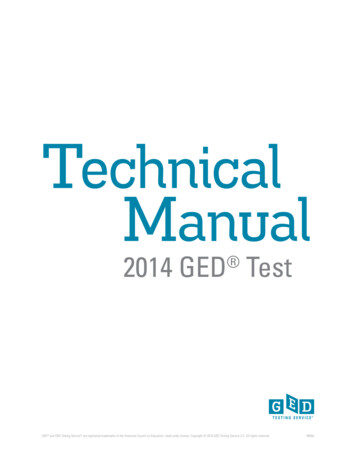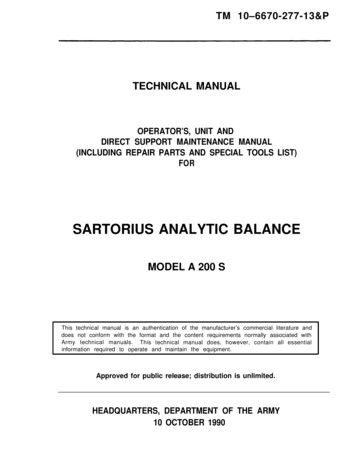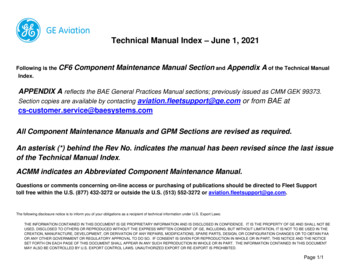
Transcription
TechnicalManual2014 GED Test GED and GED Testing Service are registered trademarks of the American Council on Education. Used under license. Copyright 2015 GED Testing Service LLC. All rights reserved. 0958a
Table of ContentsTable of Contents. 1Acknowledgments . 4Preface . 5Chapter 1: Introduction. 6About the GED Testing Program . 6GED Testing Service Vision . 6GED Testing Service Mission . 6GED Testing Service Values. 6History of the GED Tests . 7Overview of the GED Test .11GED Testing Program Assessments .11GED Test Purpose .11Intended Examinee Population .13Performance Benchmarks and Credentials .13Guiding Principles of the GED Test Design .14Global Claims .15Item Formats.16Accommodations .16Time Limits .17Test Administration .18Scoring Procedures .18Explanation of Standard Scores .19Examinee Feedback .20Chapter 2: GED Test Validity Framework .21GED Test Interpretation/Use Argument.22Target Domain Inference .22Item and Task Development Inference.23Scoring Inference.23Generalization Inference .24Extrapolation Inference .25Decision Inference .25Utilization and Consequential Inference .25Chapter 3: GED Test Development, Specifications, and Forms Development .38Assessment Development Process .38Steps in the GED Assessment Development Process: .39Part 1: Establishing Goals and Purposes for the New GED Test .41Part 2: Drafting New GED Content Frameworks and Aligning to Career- and CollegeReadiness Standards.44Part 3: Creating Item-Level Skill Descriptors .47Part 4: Science and Social Studies Practices and Content Topics .47Part 5: Creating Test Blueprints from the Assessment Targets .49 GED Test Technical Manual 1
GED Test Specifications for all Content Areas .51Item Types .51Assessment Targets for All Content Areas .57Reporting Category Descriptions for Content Areas .63Reasoning Through Language Arts Reporting Category Descriptions .64Mathematical Reasoning Reporting Category Descriptions.64Science Reporting Category Descriptions .65Social Studies Reporting Category Descriptions .66Test Development and Construction Process .67Item Field-Testing .70Mathematical Reasoning .70Science & Social Studies .70Reasoning Through Language Arts .70Calibration and Scaling of Field Test Items .70Chapter 4: Standardization and Norming, Scaling, and Equating .712012 Stand-Alone Field Test .71Item Quality Checks .72Key Outcomes of the Stand-Alone Field Test.732013 Standardization and Norming Study .74For-Hire Model and Recruiting .74Compensation.74Sample .75Recruiting of Participants .76Weighting Procedures.77Test Administration (Spiral) and Scheduling .79Scoring .80Monitoring Effort .80Calibration .82Scaling .83Chapter 5: Establishing the Performance Standard on the 2014 GED Test .85Performance Level Descriptors: Tools for Understanding Performance .85Establishment of Performance Levels on the GED Test .86The GED Passing Standard .87GED with Honors Benchmark.88Chapter 6: Scoring the GED Test .91Scoring within the Computer-Based System .91Scoring of Extended Response and Short Answer Items .91Training the Automated-Scoring Engine.92Initial Analysis Period .92Score Reporting.93Chapter 7: Reliability .94Internal Consistency Reliability .94Standard Error of Measurement .95Conditional Standard Errors of Measurement .96Reliability of Extended Response and Short Answer Scores .97Decision Consistency .99Decision Consistency Based on Content Area Tests .99 GED Test Technical Manual 2
Chapter 8: Validity Evidence .101Evidence Based on Test Content .101Content Validity Guidelines for Item Development .102Evidence Based on Internal Structure.103Item-Total Correlations .103Equivalence of Forms .104Dimensionality .105Test Bias Assessment .107Speededness Assessment .110Correlations Among Content Area Tests .110Chapter 9: Accommodations for GED Test-Takers with Disabilities .111Accommodations Procedures Summary .112Accommodations for GED Test-takers Who Are Blind or Have Visual Impairments .113Accommodations for Test-takers Who Are Deaf or Hard of Hearing .113Accommodations for Test-takers Who Have ADHD .113Chapter 10: Supplemental Materials for Test Preparation .114GED Test Tutorial .114GED Test Item Samplers .115GED Ready : The Official Practice Test .117Purposes of GED Ready .117GED Ready Test Characteristics .118Reliability of GED Ready .118Predictive Validity .121References .122Appendix A: Reasoning Through Language Arts Scoring Rubric .124Appendix B: Social Studies Scoring Rubric .127 GED Test Technical Manual 3
AcknowledgmentsGED Testing Service is pleased to issue the GED Test Technical Manual. We wish toacknowledge the work of all those who contributed to this manual.GED Testing ServiceMartin Kehe, Vice President, Assessment ServicesTracy Gardner, Senior Director, Assessment ServicesJ. Carl Setzer, Senior PsychometricianYung-chen Hsu, Senior PsychometricianMarjorie Wine, Principal Test Development ManagerMichael Bell, Senior Content Specialist—MathematicsMariana Holliday, Content Specialist—ScienceJames McKinney, Senior Content Specialist—English Language ArtsBridget Olson, Content Specialist—Social StudiesPearson SchoolAnna Topczewski, Associate Research ScientistPearson VUELinda Conheady, Test and Report EditorTechnical Advisory CommitteeNeal Kingston, Director, Achievement and Assessment InstituteRic Luecht, Professor of Educational Research Methodology at University of North Carolina atGreensboroBill Mehrens, Professor Emeritus at Michigan State UniversityBarbara Plake, Professor Emeritus at University of Nebraska–LincolnCyndie Schmeiser, Consultant and Chief of Assessment at College Board GED Test Technical Manual 4
PrefaceThis manual was written to provide technical information regarding the GED test as evidencethat the GED test is technically sound. Throughout this manual, documentation is providedregarding the development of the GED test and data collection activities, as well as evidenceof reliability and validity.This manual is made up of 10 chapters, which include the following information:Chapter 1:Introduction to the GED tests and an overview of the GED testing program,including the purposes of the tests and proper uses of test scoresChapter 2:The underlying theory of action for the GED testing program and theframework for assessing validityChapter 3:The GED test specifications and process for developing formsChapter 4:The standardization process, including the norming, scaling, and equatingprocessesChapter 5:The standard-setting process for both the High School Passing Standard andGED with HonorsChapter 6:Scoring processes for both machine- and human-scored test itemsChapter 7:The reliability of GED test scoresChapter 8:Accumulated evidence to support the validity argumentChapter 9:Various accommodations for test-takers with disabilitiesChapter 10: Supplemental materials for test preparationThis manual was written for anyone who is interested in (a) learning about the background ofthe GED testing program, (b) understanding how the GED test was developed and scored, (c)comprehending the statistical characteristics of the GED test, or (d) knowing more, in general,about the GED testing program. Individuals interested in additional information are encouragedto visit the GED Testing Service web site at www.GEDtestingservice.com. GED Test Technical Manual 5
Chapter 1: IntroductionAbout the GED Testing ProgramThe GED Testing Service is a joint venture of the American Council on Education (ACE) andPearson. Our mission, vision, and values are based on inclusiveness and diversity. Werecognize the responsibility of those in the educational community to contribute to society. Wealso embrace the belief that widespread access to post-secondary education, particularly forthose adult learners who seek lifelong learning, is the cornerstone of a democratic society.GED Testing Service VisionIn an ideal society, everyone would graduate from high school. Until that becomes a reality, theGED Testing Service will offer the opportunity to earn a high school equivalency credential sothat individuals can have a second chance to advance their educational, personal, andprofessional aspirations.GED Testing Service MissionGED Testing Service stands as the only time-honored architect of the GED test, which certifiesthe high school–level academic achievement of national and international non–high schoolgraduates. In collaboration with key partners, we develop, deliver, and safeguard our tests; weanalyze the testing program and its participants; and we develop policies, procedures, andprograms to ensure equal access to our tests.GED Testing Service ValuesThe integrity of GED Testing Service and its products rests on our commitment to excellence,diversity, inclusiveness, educational opportunities, and lifelong learning. This commitment isreflected in our proactive approach to developing collaborative solutions, our research-baseddecision making, and our timely support to the people we serve. GED Test Technical Manual 6
History of the GED TestsThe first GED tests were developed in 1942 to measure the major outcomes and conceptsgenerally associated with four years of high school education. Initiated by the United StatesArmed Forces Institute (USAFI), the original tests were administered only to military personnelso that returning World War II veterans could more easily pursue their educational, vocational,and personal goals.The USAFI examination staff, composed of civilian testing experts, worked with an advisorycommittee established with the support and cooperation of ACE, the National Association ofSecondary School Principals, and regional U.S. accrediting associations. Lindquist (1944)paved the way for the GED Tests by establishing a philosophical and technical basis for exambased equivalency. In 1945, ACE established the Veterans’ Testing Service (VTS; predecessorof today’s GED Testing Service). The VTS took over the development and administration of theGED tests and focused on helping World War II veterans pursue educational and vocationalgoals without returning them to the classroom.The opportunity to document the attainment of high school–level academic skills served as asignificant aid to the many service members whose academic careers had been disruptedduring the war. During the 1950s, it became apparent that civilians could also benefit from theprogram—a need that ACE undertook to fulfill. New York was the first state to allow nonveteranadults to take the GED tests, in late 1947. In 1955, policies regarding administration of thetests in federal correctional and health institutions were modified. By 1959, more nonveteransthan veterans were taking the GED tests. With the growth of the high school equivalencyprogram, ACE made the decision in 1960 to transfer the college-level GED tests to theEducational Testing Service (ETS). Those tests that ETS developed are known today as part ofthe College Board’s College-Level Examination Program (CLEP).From 1945 to 1963, the program was administered by the VTS. In 1958, a policy to allowoverseas testing of U.S. civilians and foreign nationals was approved. In 1963, in recognition ofthe transition to a program chiefly for nonveteran adults, the name was changed to GED TestingService. To serve all qualified examinees equally, the Commission on Accreditation of ServiceExperiences approved English-language versions in audio, Braille, and large-print formats in1964. In addition, Nova Scotia became the first Canadian province to offer GED testing tocivilians in 1969, and in 1970, the first English-language Canadian version of the GED testswas published. In 1973, GED Testing Service reached a milestone when California became thelast state to adopt a uniform acceptance of the GED tests. (For more history on the GED tests, see Mullane [2001].) GED Test Technical Manual 7
The five original GED tests in use from 1942 to 1978 were titled:Test 1: Correctness and Effectiveness of ExpressionTest 2: Interpretation of Reading Materials in the Social StudiesTest 3: Interpretation of Reading Materials in the Natural SciencesTest 4: Interpretation of Literacy MaterialsTest 5: General Mathematical AbilityThe entire battery took 10 hours to administer. (For more information about the content of thefirst generation of GED tests, see American Council on Education [1964].) In the 1970s itbecame apparent that the effects of changed secondary curricula and, perhaps, changedattitudes toward education among the general public necessitated a review of the specificationsof the GED tests. This review resulted in a thorough revision of the first series of GED tests.The second series of GED tests, introduced in 1978, was based on test specifications defined inthe mid-1970s by committees of high school curriculum specialists. Among the major changes wasthe development of a Reading Skills test to replace Test 4: Interpretation of Literary Materials, andthe reduction of the reading load in the Science and Social Studies tests. In addition, “concept” itemswere developed to make up one-third of the Science and Social Studies tests. These items requiredmuch less reading than the reading comprehension items, which dominated previous tests, but itwas assumed that examinees had some prior knowledge in science and social studies. In addition,Test 1: Correctness and Effectiveness of Expression, was replaced by a Writing Skills test. TheMathematics test included more practically-oriented test items.The second series of GED tests originally required 6 hours of test administration time. On thebasis of research (Whitney & Patience, 1981), the Commission on Accreditation of ServiceExperiences in 1981 increased the time limits for the Writing Skills Test from 60 minutes to 75minutes and for the Mathematics Test from 60 minutes to 90 minutes.This series of tests, used from 1979 through 1987, consisted of the following titles:Test 1: The Writing Skills TestTest 2: The Social Studies TestTest 3: The Science TestTest 4: The Reading Skills TestTest 5: The Mathematics Test GED Test Technical Manual 8
These tests retained the emphasis on demonstrating the designated high school outcomes butintroduced “real-life” contexts into many of the test items. They also introduced many readingmaterials likely to be encountered in an adult’s daily life (such as schedules and newspaperarticles). (For further information about the development of the second-generation tests,including detailed descriptions, see Patience and Whitney [1982].)The development of the third series of GED tests, used from 1988 through 2001, began inNovember 1982 in order to ensure that the GED tests addressed and measured the educationalacademic outcomes expected of graduating high school seniors during the late 1980s and early1990s.The Tests Specifications Committee offered recommendations for the entire GED test batterycentered on five major themes: Requiring examinees to demonstrate their higher-level thinking abilities and problem-solvingskills Including a clear emphasis on the relationship of the skills tested to aspects of the world ofwork Representing an awareness of the role and impact of computer technology Addressing certain consumer skills, and Using contexts that adult examinees would recognize and include stimulus materials related toaspects of everyday life.The GED tests introduced in 1988: Required a direct writing sample.Demanded more highly developed levels of critical thinkingReflected many roles of adultsAcknowledged the sources of change affecting individuals and societyContained contexts that adult examinees would recognize as relevant to daily life GED Test Technical Manual 9
This third series of GED tests required 7 hours and 45 minutes of test administration time. Theofficial titles of the five separate subject tests were:Test 1: Writing SkillsTest 2: Social StudiesTest 3: ScienceTest 4: Interpreting Literature and the ArtsTest 5: MathematicsIn the late 1990s, GED Testing Service undertook a study comparing national and statestandards in English language arts, mathematics, science, and the disciplines within socialstudies to survey what graduating students should know and be able to do (American Councilon Education, 1999). The major purpose of the study was to inform the education communityand the public of the development of the fourth series of GED tests. By identifying the commonelements among national and state standards and aligning the test specifications to thesestandards, GED Testing Service provided support for the claim that the GED test scores canbe used to measure what adult examinees know and are able to do relative to high schoolseniors who are completing a traditional four-year program of study.This fourth series of GED Tests (English-language U.S. and Canadian versions) was released1in 2002. The official titles of the five separate subject tests were:Language Arts, WritingSocial StudiesScienceLanguage Arts, ReadingMathematics2In 2008, GED Testing Service once again began the process of developing a new test. Aroundthat same time, the educational climate had begun a shift toward academic standards that weremore closely aligned with career- and college-readiness standards. GED Testing Serviceworked with a number of external consultants to determine its strategic course of actionregarding the direction of the program. Ultimately, it was decided that adults without a highschool diploma need to have the same opportunities to demonstrate their readiness for careersand post-secondary education.1In addition to the standard print editions, large-print, audiocassette, and Braille editions were introduced for the 2002Series at the same time. These editions were developed for those in need of special accommodations.2Historically, GED Testing Service has referred to the GED Tests (plural). With the launch of the new series in 2014,the new test is referred to in singular form as the GED test. GED Test Technical Manual 10
Overview of the GED TestGED Testing Program AssessmentsThe GED testing program comprises two assessments: GED Ready : The Official PracticeTest and the flagship GED test. These tests were developed concurrently, with similarspecifications, yet are utilized differently. GED Ready was built to the same contentspecifications as the GED test and therefore allows individuals to evaluate their likelihood ofsuccess on the GED test. GED Ready also provides an opportunity to gain additional testingexperience as well as exposure to the content and format of the GED test.The GED test is intended for jurisdictions to award a high school–level credential. The GED test is also an indication of readiness for some jobs, job training programs, and/or credit-bearingpost-secondary education coursework.Both the GED test and GED Ready are primarily administered via computer. Each test ispromptly scored by a secure system so that results may be reported to the candidate and toother relevant agencies or organizations in a timely manner. Writing prompts and performancetasks are scored using computer-based, automated scoring engines to facilitate promptreporting.3Both tests utilize a variety of item formats to tap into a range and depth of knowledge and skills.The use of multiple item types is intended to improve measurement of test-takers’ true abilities,to make the test more engaging and more reflective of real-world tasks and situations, and toincrease test-taker motivation. Both tests also leverage technology for test administration,scoring, and reporting purposes. By administering computer-based versions of each test, GEDTesting Service can standardize the test administration process, score items, and provideinterpretable feedback to the test-takers and various stakeholder groups who use the results.GED Test PurposeThe philosophy underlying the GED test is that there is a foundational core, or domain, ofacademic skills and content knowledge that must be demonstrated for an adult to be certified asprepared to enter a job, a training program, or an entry-level, credit-bearing post-secondarycourse. This foundational core of knowledge and skills is defined by career- and collegereadiness standards, now adopted in some form by the majority of states.At the same time, GED Testing Service recognizes that high scho
GED Test Technical Manual 5 Preface This manual was written to provide technical information regarding the GED test as evidence that the GED test is technically sound. Throughout this manual, documentation is provided regarding the development of the GED test and data collection activities, as well as evidence of reliability and validity.










